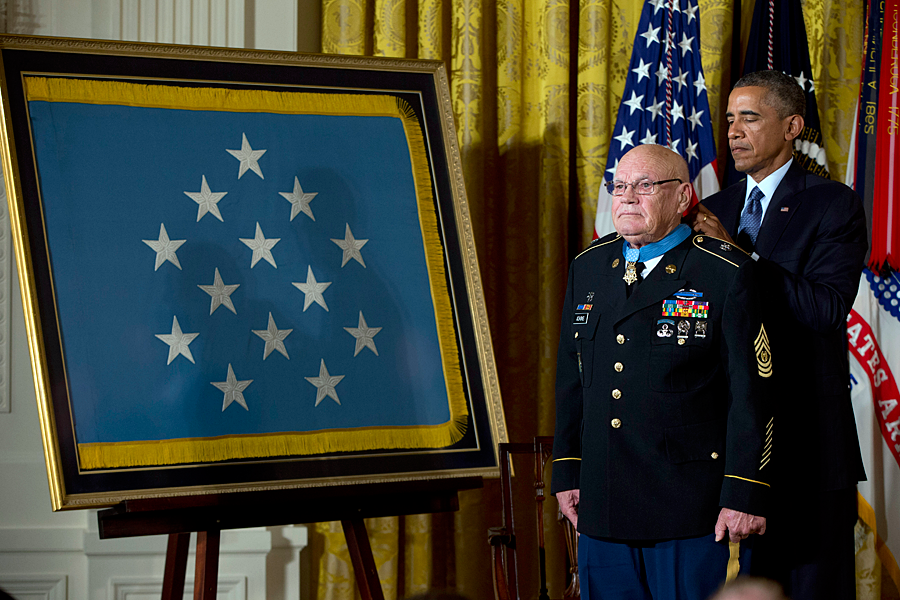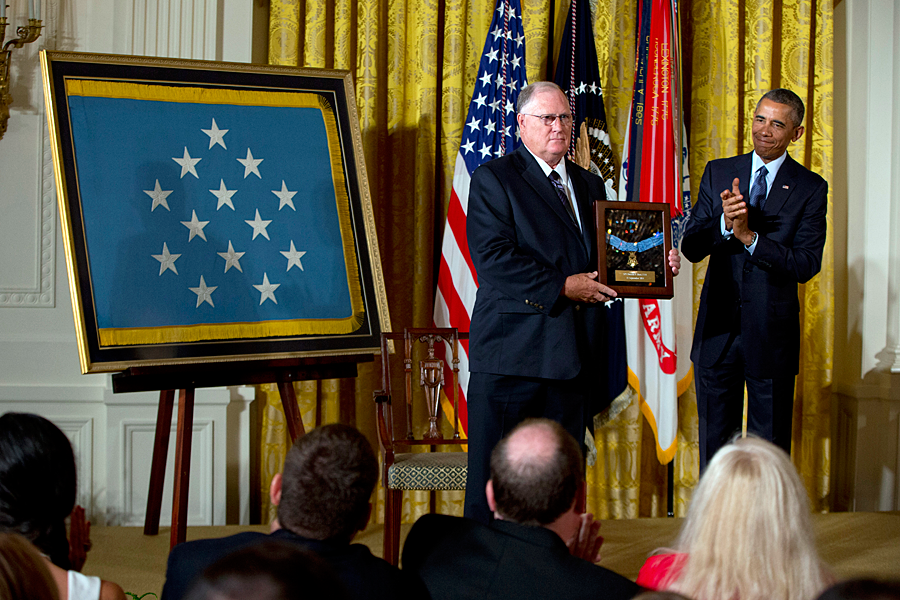Vietnam War soldiers receive Medal of Honor: Why so late?
| Washington
Nearly half-a-century ago, in 1966, a detachment of US Special Forces soldiers were crouched on the top of a small hill, deep in the jungle.
North Vietnamese forces had been pursuing them for days, and now they were surrounded, the enemy closing in on all sides.
What then-Sgt. 1st Class Bennie Adkins did in the four days of fighting that followed – including personally saving several fellow soldiers, killing “between 135 and 175 enemy troops, and sustaining 18 different wounds to his body” – earned him the nation’s highest award for valor in a White House ceremony Monday.
Command Sgt. Major Adkins, of Opelika, Ala., received the Medal of Honor in a White House ceremony, along with Spc. Donald Sloat, who was killed in 1970 when he picked up an enemy’s live grenade and drew it to his body, saving the lives of the US soldiers around him.
Even before that act of selflessness, Specialist Sloat had been one of the most liked guys in his company – and one of the bravest. His patrol had been ambushed twice earlier, and both times Sloat had been recognized for valor.
“I guess they think I’m really gung-ho or something,” he had written home in a letter to his parents.
So, what took so long for these soldiers – who served with such conspicuous valor – to receive these awards?
President Obama acknowledged the lag time in his remarks during the ceremony.
“Normally, this medal must be awarded within a few years of the action,” he told the assembled audience. “But sometimes even the most extraordinary stories can get lost in the fog of war.”
When new evidence comes to light, “certain actions can be reconsidered for this honor,” he added.
Both Adkins and Sloat were awarded the Distinguished Service Cross – the nation’s second highest military medal – in the months after their valorous acts. But the Medal of Honor process requires “incontestable proof of the actions for which the individual is being recognized,” according to Army regulations. This includes files filled with eyewitness statements, diagrams, and maps.
In 2002 however, the National Defense Authorization Act included a clause that required the record of each Jewish and Latino veteran to be reviewed for possible upgrade to Medals of Honor, in an effort to correct bias that may have prevented these troops from receiving these awards in the first place.
The Army in turn commissioned a review of 6,505 recipients of the Distinguished Service Cross from World War II, as well as the Korean and Vietnam wars.
As a result, in a White House ceremony in March, two-dozen veterans received the Medal of Honor in a single ceremony, the second largest of its kind.
In the process of the review, the Department of Defense discovered something else, too: seven veterans “who did not meet the exact criteria of the congressionally mandated review but who, nevertheless, were deserving of the Medal of Honor,” says Wayne Hall, an Army spokesman.
The awards of Adkins and Sloat were due in large part to “the advocacy and admiration of loved ones, and of those who served with them,” he added.
For decades, Sloat’s family knew only that he had been killed in action.
“Late in her life, Sloat’s mother finally learned the full story, and she made it her mission to have Don’s actions properly recognized,” Mr. Obama said.
While Mrs. Sloat passed away three years ago, “She always believed – she knew – his day would come,” he added. “She even bought a special dress to wear to the ceremony.”
Sloat’s brother accepted the award on his behalf.
As for Adkins, during the multi-day battle for which he received the Medal of Honor, he performed “so many acts of bravery that we actually don’t have time to talk about all of them,” Obama said.
He named a few – including enduring wave after wave of enemy assaults from a mortar pit. Three times he was blasted out of it by enemy fire, and three times he returned. He fought hand to hand, and threw his body between a Vietnamese soldier and his own comrade-in-arms, saving his life.
Then, “exhausted and surrounded with the enemy closing in,” Adkins and his fellow soldiers heard something else amidst the gunfire: the growls of a tiger.
The animal at last caused the North Vietnamese soldiers to leave.
“They were more scared of that tiger than they were of us,” the president recalled Adkins saying, adding,“You can’t make this up.”






